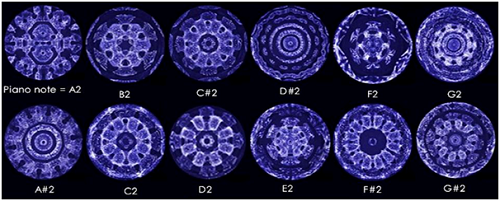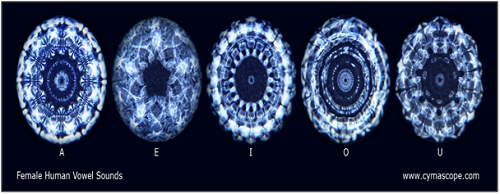We all know that sound is audible. Can we imagine that sound can be visible! Oh yes sound can be visible. Cymatics, the study of wave phenomena and vibration, is a scientific methodology that demonstrates the vibratory nature of matter and the transformational nature of sound. It is acoustic science at its finest, and its implications are vast! The term (Kymatiks in German), was adapted from the Greek word for wave, ta Kyma, in the 1960s by Swiss medical doctor and natural scientist, Hans Jenny (1904-1972).
Application of Cymatics:
In collaboration with musician, Matthew Calder, we imaged a short Halo Drum melody as part of our ongoing development of
MusicMadeVisible in which the complex harmonic structures within music are made visible in real time video mode on the CymaScope instrument. No color was added to the video. The Halo Drum features a highly distinctive mix of harmonics and the sustain of each note, particularly the C3, is several seconds in duration, allowing the harmonics to be rendered visible.


Above pictures are two CYMAGHYPHS of Piano notes and Female Human Vowel Sounds.So Next Question is what is Cymaghyphs?
Whenever sound bubbles or beams interact with a membrane, the sound vibrations imprint onto its surface and form a CymaGlyph, a repeatable pattern of energy. The CymaScope employs the surface tension of water as a membrane because water reacts quickly and is able to reveal intricate architectures within the sound form. These fine details can be captured on camera. Here The CymaScope is a new type of scientific instrument that makes sound visible. Its development began in 2002, with a prototype that featured a thin, circular, P.V.C. membrane;later we used latex. Fine particulate matter was used as the revealing media. However, it was soon discovered that far greater detail could be obtained by imprinting sonic vibrations on the surface of ultra pure water. The surface tension of water has high flexibility and fast response to imposed vibrations, even with transients as short-lived as a few milliseconds. Therefore,water is able to translate many of the sinusoidal periodicities-- in a given sound sample-- into physical sinusoidal structures on the water’s surface. Current limits to imprinting sound on water occur in the higher harmonics and are due mainly to there being insufficient energy available in this area of the audio spectrum to cause excursions of the surface tension membrane.
Animal communication has been studied for decades although reliably identifying animal sounds has proven to be extraordinarily difficult. However, some good work has been achieved in this area and we will post articles on this subject in the coming weeks. Holding a 'conversation' with another species remains a dream for zoologists and ornithologists but recent research in the field of dolphin communication, using the CymaScope, is beginning to show promise.Dolphins enjoy constant auditory and visual stimulation throughout their lives, a fact that may contribute to their hemispheric brain coordination. The dolphin’s auditory neocortical fields extend far into the midbrain, influencing the motor areas in such a way as to allow the smooth regulation of sound-induced motor activity as well as sophisticated phonation needed for production of signature whistles and sonopictures. These advantages are powered not only by a brain that is comparable in size to that of a human but also by a brain stem transmission time that is considerably faster than the human brain.
Researchers in the United States and Great Britain have made a significant breakthrough in deciphering dolphin language in which a series of eight objects have been sonically identified by dolphins. Team leader, Jack Kassewitz of Speak Dolphin.com, ‘spoke’ to dolphins with the dolphin’s own sound picture words. Dolphins in two separate research centers understood the words, presenting convincing evidence that dolphins employ a universal “sono-pictorial” language of communication.
Researchers in the United States and Great Britain have made a significant breakthrough in deciphering dolphin language in which a series of eight objects have been sonically identified by dolphins. Team leader, Jack Kassewitz of SpeakDolphin.com, ‘spoke’ to dolphins with the dolphin’s own sound picture words. Dolphins in two separate research centers understood the words, presenting convincing evidence that dolphins employ a universal “sono-pictorial” language of communication.
Ornithology is a branch of zoology that concerns the study of birds. Several aspects of ornithology differ from related disciplines, due partly to the high visibility and the aesthetic appeal of birds. Most marked among these is the extent of studies undertaken by amateurs working within the parameters of strict scientific methodology.Father of Indian Ornithologist Dr. Salim Ali first try to use cymascope like instrument for understanding communication among the weaver birds.Dr SalimAli would spend most of his time researching about the activities of the weaver bird.He published a research paper discussing the nature and activities of the weaver bird in 1930. The article made him famous and established his name in the field of ornithology.
Phonology is the systematic use of sound to encode meaning in any spoken human language, or the field of linguistics studying this use. Just as a language has syntax and vocabulary, it also has a phonology in the sense of a sound system. The CymaScope represents a significant breakthrough in the study of phonology and as a powerful audio-visual aid in speech pathology/therapy and vocal coaching. The instant production of voice figures or "CymaGlyphs" as a result of the client's own vocalizations can provide visual feedback that not only allows the client to shape their sounds visually, thus improving articulation and intonation, but also provides an effective method of enhancing pitch recognition. In addition vibrato can be taught or modified.
THEORIES OF SOUNDS OF ‘OM’:CYMATICS AND SHIVA
The sound of the ‘Om’ is said to have been found out by Indian Rishis ages ago. Sound has been the root for the shaping of objects and everything around us, including ourselves. The sound of 'Om' is noted to be a C#. (C sharp)
The Sri Yantra was then developed when they found out that the sound of ‘Om’ formed a particular pattern when it was sang out perfectly. This pattern was then taken as a sacred symbol. Note, it is all sacred geometry!
REFERENCES: